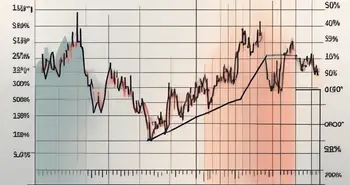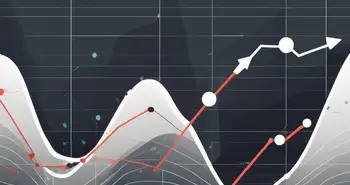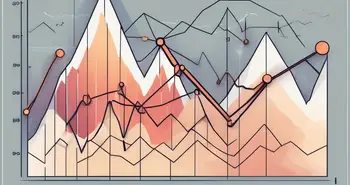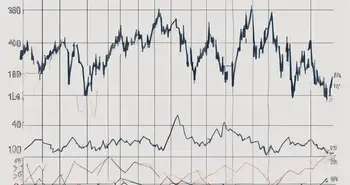An In-Depth Guide to Aroon: Understanding and Utilizing this Powerful Technical Indicator

I have been trading in the financial markets for over a decade, and during my journey, I have come across numerous technical indicators that help in making informed trading decisions. One such powerful tool that I want to shed light on today is the Aroon indicator. In this in-depth guide, we will dive deep into understanding the basics of Aroon, decoding the Aroon formula, learning how to use Aroon in trading, debunking common misconceptions, and enhancing your trading strategy with Aroon. So buckle up and let's explore the world of Aroon together!
Understanding the Basics of Aroon
When it comes to technical analysis, there are numerous indicators available to traders. One such indicator is Aroon, which was developed by Tushar Chande in 1995. Aroon aims to identify the strength and direction of a trend, making it a valuable tool for traders looking to make informed decisions. Let's take a closer look at what Aroon is and how it works.
What is Aroon?
Before we delve into the technicalities, let's get a grasp of what Aroon actually is. Aroon consists of two lines, namely Aroon Up and Aroon Down, which oscillate between 0 and 100. The Aroon Up line measures how long it has been since the highest high within a given period, while the Aroon Down line measures how long it has been since the lowest low within the same period.
By analyzing the relationship between these two lines, traders can gain insights into the momentum of a trend. Aroon can be used to identify the beginning of a new trend, as well as potential trend reversals.
The Importance of Aroon in Technical Analysis
In the vast sea of technical indicators, where does Aroon stand? Well, Aroon has a unique edge as it focuses on the timing of trend changes rather than just identifying them. While other indicators may provide information about the existence of a trend, Aroon helps traders anticipate when a trend is losing steam or when a new trend is about to emerge.
By providing early signals, Aroon can be a valuable tool to avoid getting caught on the wrong side of the market. Traders can use Aroon to confirm the strength of a trend and make more informed decisions about when to enter or exit a trade.
Components of the Aroon Indicator
Now that we understand the purpose of Aroon, let's break down its components. As mentioned earlier, there are two lines: Aroon Up and Aroon Down. These lines represent the time that has passed since the highest high and lowest low, respectively.
In addition to the lines, there are two more metrics to consider: Aroon Up Position and Aroon Down Position. These metrics represent the percentage of time since the highest high and lowest low, respectively. By analyzing both the lines and positions, traders can gain a comprehensive picture of the market trend.
It's important to note that Aroon is not a standalone indicator. Traders often use it in conjunction with other technical analysis tools to confirm signals and make more accurate predictions.
In conclusion, Aroon is a powerful technical indicator that can help traders identify the strength and direction of a trend. By analyzing the relationship between the Aroon Up and Aroon Down lines, as well as the Aroon Up Position and Aroon Down Position metrics, traders can make more informed decisions about when to enter or exit a trade.
Decoding the Aroon Formula
The Aroon formula is a powerful tool used in technical analysis to identify trends and potential trend reversals in financial markets. While the mathematics behind the Aroon formula may seem intimidating at first, it is essential to understand the inner workings of this indicator. By delving into the calculations and interpreting the Aroon values, traders can gain valuable insights into market dynamics.
The Mathematics Behind Aroon
The calculations involved in the Aroon formula are relatively straightforward:
- Calculate the number of periods since the highest high (Aroon Up Period).
- Calculate the number of periods since the lowest low (Aroon Down Period).
- Calculate the Aroon Up and Aroon Down lines by converting the periods into percentages.
These calculations allow traders to track the trend strength over a specific period and unveil potential trend reversals. By quantifying the time elapsed since the highest high and lowest low, the Aroon formula provides a numerical representation of market momentum.
Interpreting Aroon Values
Now that we have the Aroon lines and positions, it's time to interpret what they actually mean. The Aroon Up line represents the strength of the bullish trend, while the Aroon Down line represents the strength of the bearish trend. By analyzing these values, traders can gauge the market sentiment and make informed trading decisions.
When the Aroon Up line is consistently above 70 and the Aroon Down line is consistently below 30, it suggests a strong bullish trend. This indicates that buyers are in control, and the price is likely to continue rising. Conversely, when the Aroon Down line is consistently above 70 and the Aroon Up line is consistently below 30, it indicates a strong bearish trend. In this scenario, sellers dominate the market, and the price is expected to decline further.
Furthermore, the Aroon Up and Aroon Down positions give insight into the trend's lifespan. Higher values indicate a more mature trend, while lower values suggest the beginning or end of a trend. Traders can use this information to assess the potential duration of a trend and adjust their trading strategies accordingly.
Aroon Up and Aroon Down
Although the Aroon Up and Aroon Down lines provide valuable information individually, it is their combination that offers a complete picture. By analyzing the crossovers between these lines, traders can identify potential trend reversals and generate trading signals.
When the Aroon Up line crosses above the Aroon Down line, it signals a potential trend reversal from bearish to bullish. This crossover suggests that the selling pressure is diminishing, and buyers are gaining control of the market. On the other hand, when the Aroon Down line crosses above the Aroon Up line, it indicates a potential trend reversal from bullish to bearish. This crossover implies that the buying momentum is waning, and sellers might take over.
These crossovers are often considered as trading signals by technical analysts. Traders can use them to enter or exit positions, depending on their trading strategies and risk appetite. However, it is important to note that no indicator is foolproof, and additional analysis is always recommended to validate the signals generated by the Aroon formula.
In conclusion, the Aroon formula is a valuable tool for traders seeking to understand market trends and potential reversals. By delving into the mathematics behind the formula and interpreting the Aroon values, traders can gain a deeper understanding of market dynamics and make more informed trading decisions.
How to Use Aroon in Trading
Identifying Market Trends with Aroon
One of the primary applications of Aroon in trading is identifying market trends. By monitoring the Aroon Up and Aroon Down lines, traders can gauge whether the market is trending upwards, downwards, or in a sideways range. A strong Aroon Up line, coupled with a weak Aroon Down line, suggests a bullish trend, while the opposite indicates a bearish trend. Aroon can be especially beneficial for trend-following strategies.
When using Aroon to identify market trends, it is important to consider the time frame being analyzed. Aroon can be used on various time frames, such as daily, weekly, or monthly charts, to gain a better understanding of the overall trend. Traders often look for consistency in the Aroon readings across different time frames to confirm the strength of a trend.
Furthermore, Aroon can also be used in conjunction with other technical indicators to validate market trends. For example, traders may combine Aroon with moving averages or trendlines to confirm the direction of the market. By using multiple indicators, traders can increase the accuracy of their trend analysis and make more informed trading decisions.
Spotting Potential Reversals
Another way to utilize Aroon is to identify potential trend reversals. When the Aroon Up line crosses above the Aroon Down line, it suggests a shift from bearish to bullish sentiment. Conversely, when the Aroon Down line crosses above the Aroon Up line, it indicates a shift from bullish to bearish sentiment. These crossovers serve as early warning signs for traders to adjust their positions or even consider taking opposite trades.
It is important to note that Aroon crossovers alone may not be sufficient to confirm a trend reversal. Traders often look for additional confirmation signals, such as changes in volume or other technical indicators, to validate the reversal. By combining Aroon with other tools, traders can increase the probability of accurately identifying trend reversals and avoid false signals.
Moreover, Aroon can also be used to identify potential trend continuation after a brief pullback or consolidation. If the Aroon lines remain strong even during a temporary pause in the trend, it suggests that the overall trend is still intact, and traders can consider entering or adding to their positions.
Aroon and Volatility
Volatility plays a crucial role in trading, and Aroon can provide valuable insights in this aspect as well. When the Aroon Up and Aroon Down lines are close to each other, it signifies a period of low volatility, often seen during consolidation or indecisiveness in the market. Traders may interpret this as a potential calm before a storm, where a breakout or significant price movement could occur.
On the other hand, when the Aroon lines diverge, it suggests increasing volatility, hinting at potential price breakouts or strong trends. Traders who seek to capitalize on volatility may consider entering trades when the Aroon lines start to diverge, as it indicates a higher probability of significant price movements.
It is important to note that while Aroon can provide insights into volatility, it should not be the sole indicator used to assess market conditions. Traders should consider using Aroon in conjunction with other volatility indicators, such as Bollinger Bands or Average True Range (ATR), to gain a more comprehensive understanding of market volatility.
In conclusion, Aroon is a versatile technical indicator that can be used in various ways to enhance trading strategies. Whether it is identifying market trends, spotting potential reversals, or assessing volatility, Aroon provides valuable information to traders. By incorporating Aroon into their analysis, traders can make more informed decisions and increase their chances of success in the dynamic world of trading.
Common Misconceptions about Aroon
Aroon is a popular technical indicator used by traders to identify trend direction and timing in the financial markets. While Aroon is a powerful indicator, there are common misconceptions that can lead traders astray. It is important to have a clear understanding of these misconceptions to make informed trading decisions.
Misinterpretation of Aroon Signals
One of the most frequent errors traders make is solely relying on Aroon for trading decisions. While Aroon can provide valuable insights into market trends, it is crucial to use it in conjunction with other technical indicators or analysis methods to validate the signals. By combining Aroon with other indicators such as moving averages or volume analysis, traders can gain a more comprehensive view of the market and increase the accuracy of their trading decisions.
Additionally, it is important to note that Aroon is not infallible and can produce false signals, especially during choppy or range-bound market conditions. Traders should be cautious when relying solely on Aroon signals and consider the broader market context before making any trading decisions. By analyzing other factors such as market sentiment, economic news, or fundamental analysis, traders can avoid potential pitfalls and increase their chances of success.
Limitations of the Aroon Indicator
Like any technical indicator, Aroon has its limitations. While it performs best in trending markets, it may prove less effective during times of low volatility or when the market is moving sideways. Traders should be aware of these limitations and adjust their trading strategies accordingly.
Moreover, it is important to understand that Aroon has a limited scope in predicting the magnitude of price movements or the duration of trends. It is primarily designed to identify trend direction and timing, rather than providing precise price targets. Traders should not solely rely on Aroon to determine their profit targets or stop-loss levels. Instead, they should consider other factors such as support and resistance levels, Fibonacci retracements, or candlestick patterns to enhance their trading strategies.
In conclusion, while Aroon is a valuable tool for identifying trend direction and timing, it is important to use it in conjunction with other indicators and analysis methods. Traders should be aware of the limitations of Aroon and consider the broader market context when interpreting its signals. By doing so, traders can make more informed trading decisions and increase their chances of success in the financial markets.
Enhancing Your Trading Strategy with Aroon
Combining Aroon with Other Technical Indicators
To maximize the effectiveness of Aroon, consider combining it with other technical indicators. For example, pairing Aroon with moving averages can provide additional confirmation of trend strength and help filter out false signals. Similarly, using Aroon alongside oscillators like Relative Strength Index (RSI) or Stochastic Oscillator can give a more comprehensive view of market conditions. Experimenting with different indicator combinations can help fine-tune your trading strategy.
Aroon and Risk Management
Risk management is a crucial aspect of trading success, and Aroon can play a role in this area as well. By monitoring the Aroon Up and Aroon Down positions, traders can assess the strength and sustainability of a trend. Additionally, Aroon crossovers can be used to set stop-loss orders or take-profit levels, allowing traders to manage their risk effectively. Remember, while Aroon provides valuable insights, it is crucial to incorporate proper risk management techniques into your overall trading plan.
Fine-Tuning Your Approach with Aroon
As with any technical indicator, personal experience and trading style play a significant role in utilizing Aroon effectively. Each trader has their unique preferences and risk tolerance. Therefore, it is essential to backtest and experiment with different settings and timeframes to find what works best for your trading approach. Keep a journal of your Aroon-based trades and learn from your successes and failures. Over time, your expertise in using Aroon will grow, contributing to your overall trading success.
FAQ
Q1: What is the purpose of the Aroon indicator?
A1: The Aroon indicator aims to identify the strength and direction of a trend, providing valuable insights for traders to make informed trading decisions.
Q2: How does the Aroon indicator help in spotting potential trend reversals?
A2: Aroon helps spot potential trend reversals by monitoring the crossover of the Aroon Up and Aroon Down lines. When the Aroon Up line crosses above the Aroon Down line, it indicates a potential shift from bearish to bullish sentiment.
Q3: Can the Aroon indicator be used in range-bound markets?
A3: While Aroon performs best in trending markets, it can still provide insights in range-bound markets, primarily by indicating periods of low volatility and potential price breakouts.
Q4: Should I solely rely on the Aroon indicator for my trading decisions?
A4: It is not recommended to solely rely on the Aroon indicator for trading decisions. It is important to use Aroon in conjunction with other technical indicators or analysis methods to validate the signals and consider the broader market context.
Q5: How can I enhance my trading strategy with the Aroon indicator?
A5: To enhance your trading strategy with Aroon, consider combining it with other technical indicators such as moving averages or oscillators. Additionally, focus on risk management and fine-tune your approach through backtesting and journaling your trades.
As you embark on your journey of mastering the Aroon indicator, remember that practice and experience are key. Like with any technical tool, it takes time to understand its nuances and apply it effectively in your trading. Combine your knowledge of Aroon with other analysis methods, follow risk management principles, and most importantly, trust your instincts. Soon enough, you'll be harnessing the power of Aroon to navigate the dynamic world of trading with confidence and precision!
Ready to take your trading to the next level with the insights gained from the Aroon indicator? Join Morpher, the revolutionary trading platform that empowers you with zero fees, infinite liquidity, and the ability to trade a vast array of assets from stocks to sneakers. With Morpher, you can leverage the power of blockchain technology to enhance your trading strategy, enjoy fractional investing, and even engage in short selling without interest fees. Experience the future of trading with the safety and control of a non-custodial Morpher Wallet and amplify your trades with up to 10x leverage. Don't miss out on this unique trading experience. Sign Up and Get Your Free Sign Up Bonus today and start trading on Morpher.com!

Disclaimer: All investments involve risk, and the past performance of a security, industry, sector, market, financial product, trading strategy, or individual’s trading does not guarantee future results or returns. Investors are fully responsible for any investment decisions they make. Such decisions should be based solely on an evaluation of their financial circumstances, investment objectives, risk tolerance, and liquidity needs. This post does not constitute investment advice.

Painless trading for everyone
Hundreds of markets all in one place - Apple, Bitcoin, Gold, Watches, NFTs, Sneakers and so much more.

Painless trading for everyone
Hundreds of markets all in one place - Apple, Bitcoin, Gold, Watches, NFTs, Sneakers and so much more.









